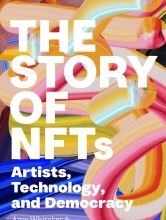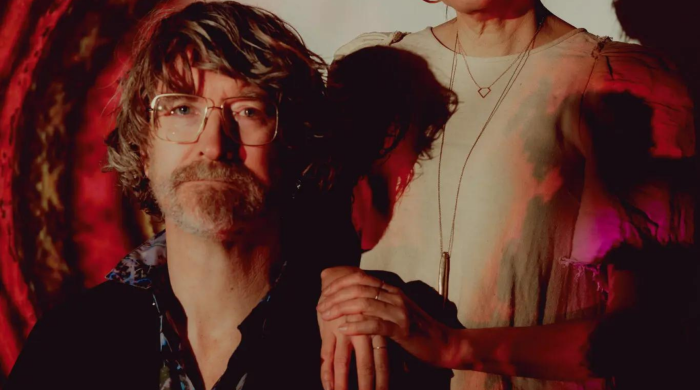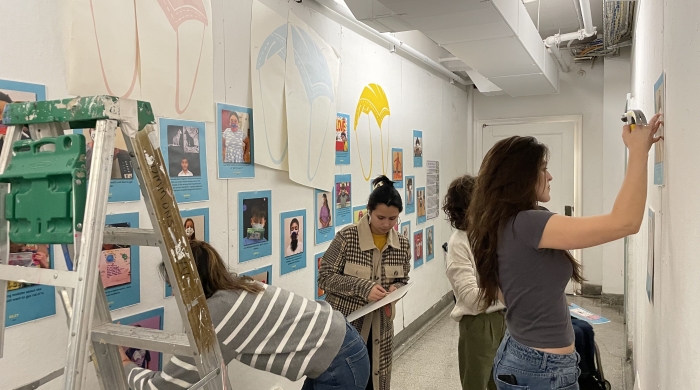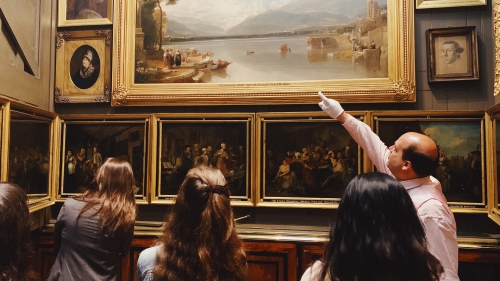For many casual audiences, NFTs (non-fungible tokens) are a black box of technological jargon.
A new book – co-authored by Amy Whitaker, associate professor of visual arts administration, and Nora Burnett Abrams, Mark G. Falcone Director of MCA Denver and NYU Institute of Fine Arts (IFA) alum – seeks to change that.

Whitaker and Abrams celebrated the publication of The Story of NFTs: Artists, Technology, and Democracy at a recent launch event, hosted at the IFA. Their conversation centered on the power of NFTs to democratize the art world – and the importance of educating everyone from artists to art professionals to art lovers about what this technology is and what impact it could have.
For Whitaker, whose research focuses on fractional equity in art using blockchain as a new structure of economic stability for artists, The Story of NFTs was an opportunity to blend academic rigor with a public-facing effort to demystify the technology and build a conversation about its potential from the foundation up.
Whitaker describes blockchain, the technological base of an NFT, as a decentralized database structure: “It’s a public record that is append-only; you can add things but you can’t subtract them. We take for granted how much trust we put in centralized authorities, and this is a very novel method of applying the wisdom of crowds to a cryptographic form. An NFT is a unique digital identifier that is registered to a blockchain, as a sort of certificate of authenticity.”
For me, it is the emergence of these new forms of support for artists that is structurally interesting – that is seismic.
Just as they can be authenticated, NFTs can be sold or traded, meaning that a digital piece created by an artist can be traced back to that artist. This system has major implications for the possibility of collective ownership of art and for resale royalties for artists.
Conversations around NFTs echo longstanding debates in the art world around authority, provenance, and pay.
As Whitaker shared, “Some of the earliest analysis in the world of cryptography was about how easy it is to manipulate a digital file; how can we trust a record of the past without having to trust a central administrator to keep the record? NFTs answer a question of provenance that is also being asked in the arts: how do we know what we know and how we trust it?”
Abrams also emphasized the similarities between historic debates in the art world and contemporary questions raised by NFTs.
“There is a lot of resonance between how we talk about this technology and the very utopian way people spoke at the advent of what we now talk about as conceptual art, in the 1960s,” she said. “Artists were attempting to circumvent the market and the systems of inequities that they recognized and did not want to participate in. They began creating work that could not be acquired and objectified. Now we are echoing those conversations some 50 years later in service of the same ideals and motivations.”
NFTs, and the technology that supports them, have the power to advance the values of equity, engagement, and economic stability for artists, while also challenging institutions to rethink the practices and policies surrounding the collection and sale of artwork. For Whitaker, NFTs also make evident the interconnection between art and economics, to the benefit of artists.
Whitaker shared, “For me, it is the emergence of these new forms of support for artists that is structurally interesting – that is seismic.”
The IFA launch event was moderated by Matthew Israel, author of A Year in the Art World and former commissions lead of Open Arts at Meta, and introduced by Christine Poggi, professor of fine arts and Judy and Michael Steinhardt Director of the IFA. The Story of NFTs was co-published by Rizzoli and MCA Denver on March 7, 2023.
Related Articles
Professors Amy Whitaker and Kevin McCoy Featured in NYTimes
"One Year After Beeple, the NFT Has Changed Artists. Has It Changed Art?"
Performing Arts and Visual Arts Administration Study Abroad 2022
Students in the Performing Arts and Visual Arts Administration graduate programs traveled to Berlin and Paris as a part of the Issues and Practices in Arts Administration: The European Context course.
Art Therapy Program Students and Faculty Display the Parachute Project in the Barney Building
The Parachute Project, initiated by the art therapy program, is a contribution to the global effort called for by UNICEF to understand the impact of the pandemic on children and adolescents.



